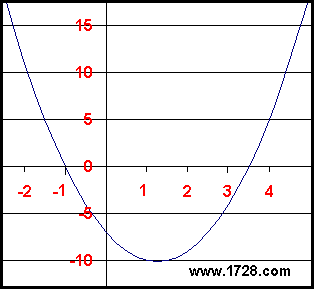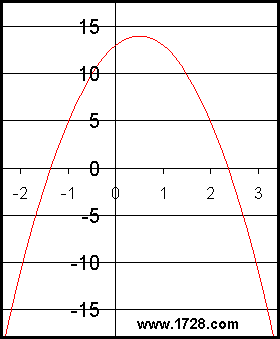|
Minimum & Maximum Values Part I
One of the most important uses of calculus is determining minimum and maximum
values. This has its applications in manufacturing, finance, engineering, and a
host of other industries.
Before we examine a real-world example, we should learn how to calculate
such values.
Let's use for our first example, the equation 2X2 -5X -7 = 0 
This is a quadratic equation in one variable. That is to say it is an equation of the form: With equations of this type, we know that when the "a" term is positive, the graph of the curve will be "concave up" (U-Shaped) and therefore the equation will have a minimum value but no maximum value (okay - technically, the maximum value is infinity). Looking at the graph we see that the minimum point is roughly X = 1.5 and Y = -10. Is there a way to determine the minimum point without graphing the equation and getting an exact value? Yes there is ! Look at the graph. If slope values were calculated for points on the left side of the curve, you could see that the slope would always be negative but it becomes "less negative" the closer the curve approaches the minimum (the bottom). If the slope were calculated along the right side of the curve, the value would always be positive and the slope values would get larger the further away from the "bottom" the points were.
So, it is logical to think that the slope is zero at that "bottom" point
and therefore the derivative is zero at that point too.
In this example we knew that we were obtaining a minimum value because
we graphed it. Also, we stated that the "rule" for quadratic equations is such
that when the 'a' term is positive, the curve will be "concave-up". There is yet
a third method to determine whether a point is a maximum or minimum value. For equations of the type aX2 + bX + c =0, a handy tool to use is the Quadratic Equation Calculator. Not only does this calculate the roots of the equation, it will also show the derivative and the point at which the maximum or minimum exists. The second example we will look at is very similar to the previous one, except that it is "concave down" instead of "concave up". If you think you understand the concepts presented so far, then move on to Part II
Okay, let's examine this equation: 
We learned from the first example that the way to calculate a maximum (or minimum) point is to find the point at which an equation's derivative equals zero. The derivative of this equation is: Taking the second derivative of -8X + 4, we get -8. Since this is negative, it means that we have found a maximum value. Now it is time to move on to Part II
|